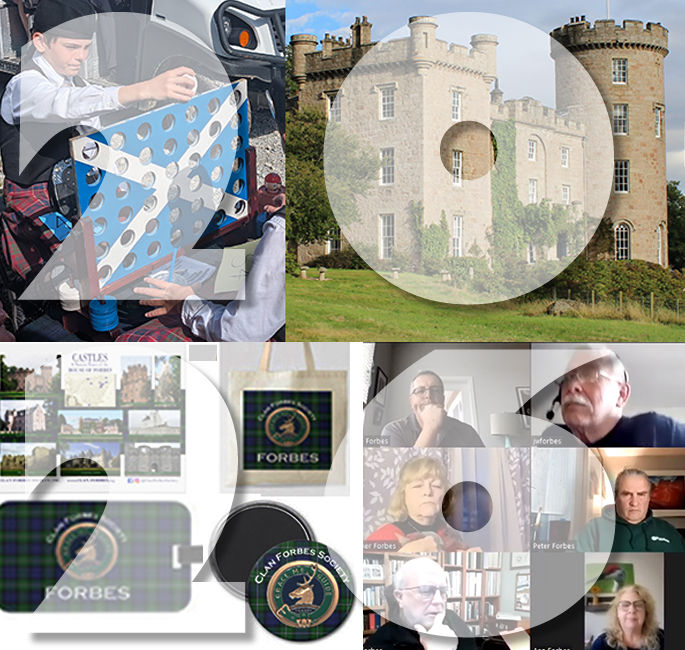Heritage of Hogmanay
- Bart Forbes

- Dec 27, 2019
- 3 min read

Hogmanay is a quintessentially Scottish holiday: born of pagan mysticism, enlivened with Viking bravado, challenged by religious clashes, and enriched by local traditions.
During the 16th century Protestant Reformation, Lord Protector Oliver Cromwell (1599 – 1658) effectively banned Christmas for 400 years. In fact, Christmas Day didn’t become a public holiday in Scotland until 1958. Instead, Scots celebrated the mid-winter holiday of Hogmanay with their friends and families. Today, Hogmanay is one big party in such urban centers as Edinburgh. (See: https://www.edinburghshogmanay.com.)
In The Scot’s Magazine of June – November 1898, clan member Eric Forbes offered his personal view of the celebration.

He admits that Hogmanay “is to a considerable extent veiled in the mists of antiquity.” However, he notes that “History rather points to the fact that all the northern tribes paid a sort of religious veneration to the night rather than the day, and this predilection for the former induced our ancestors, the Saxons, to begin all their computations of time from the night rather than the day.” Thus, the beginning of the new year is marked by the winter rather than summer. He conjectures that “Saxons probably acquired the custom of celebrating Hogmanay from the Scandinavian or Icelandic tribes, who held his festival and other religious rites in the month of December, under the name of Hogmonat and Blothmont, signifying in ancient Icelandic the month of immolation or sacrifice. The ancient Scandinavian name for the night preceding the feast of Yule was “Hogenat,” referencing the animals slaughtered on that occasion for sacrificial or festal purposes.

Forbes recounts the Hogmanay practices of his own time, such as “The simple ceremony in our own country of the unbarring of the entrance door, as the clock struck twelve, to let the old year out and the new year in, was one which used to be enacted with great formality.” He relates the local custom in fishing ports in Morayshire of "burning the clavie.'' This consisted of burning herring barrels with peats and then carrying home the burning embers as a protection from the “ills of life.” Forbes also shares the combined celebration of of the “wassail-bowl” and “first-footing.” Scots prepared a “hot pint” or a kettle-full of warm spiced ale, fortified with spirits. At midnight, families drank and toasted each other: “A good health and a happy new year, and many of them.” The elders would then visit their neighbors with the “hot pint” and a provision of buns, shortbread, bread, and cheese. He notes that “If they were the first to enter the house since twelve o'clock, then they were deemed as the “first-foot,” and as such it was most important for the luck to the family in the coming year that they should make their entry with their hands full of cakes and cheese.” This custom was popular in the early 19th century in Edinburgh – until an unfortunate incident in 1812 almost extinguished this tradition.

A gang of youths plundered the Hogmanay celebrants and beat anyone who resisted. The result was the deaths of a policeman, Dugald Campbell (fondly called “Royal Arch”), and a clerk, James Campbell. City magistrates offered a reward of two hundred guineas. The culprits were caught and convicted: Hugh M'Intosh, Neil Sutherland, and Hugh M'Donald, On April 22, the three young men were executed on a gibbet erected at the scene of the crime in the High Street, exactly opposite the Old Stamp Office Close. From that time, the old custom of going about with a “hot pint” fell off.
Fortunately, the hardy Scots slowly revived the celebration. For many years, the Edinburgh observances was an informal street party focused on the Tron Kirk in the High Street of the Old Town. The event was more formally organized in 1993 and moved to Princes Street. In 1996, over 300,000 people attended, leading to ticketing of the main street party in later years up to a limit of 100,000 tickets.
Today, the Edinburgh version of Hogmanay starts with a massive torchlit parade on the December 30, includes a huge fireworks display, features performances from musicians ranging from up-and-coming acts to pop stars and the odd superannuated rock group, and pulls a crowd from more than 60 different countries.
Read the complete 1898 Scots Magazine article "Hogmanay: Its Origin and Customs" by Eric Forbes here. For a more in-depth look at the origins of Hogmanay, see my article "A Gift at New Year: Reclaiming Scottish Hogmanay", published in the January 2000 edition of The World & I: The Magazine for Lifelong Learners, a publication of the Washington Times.




Interesting! Blothmont is from Blot and means sacrifice (Blot månad/month). Jul (Yule) or Christmas was called and is sometimes still called Julablot, which means the sacrifice of the Jul. Derived probably from the feast following the winter slaughter of animals, and hanging parts of the "sacrified" animals in a tree. I guess changing them into nice sparkly and shiny bulbs is more suitable now a days.. In scandinavia we still say God Jul, which is translated to Happy Jul/Christmas. Hogmanay sounds a bit like "högmånad" in swedish, meaning high month, or peak month. Not sure what that could mean.
Auld lang syne sounds also a bit scandinavian. Lang syne sounds like or is pronounced like the scandinavian "länge sedan" meaning…